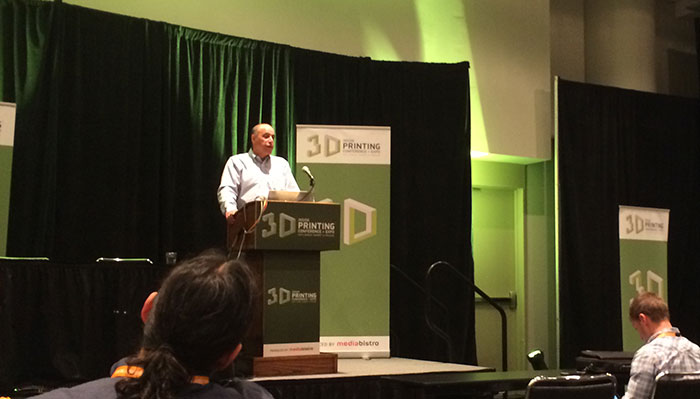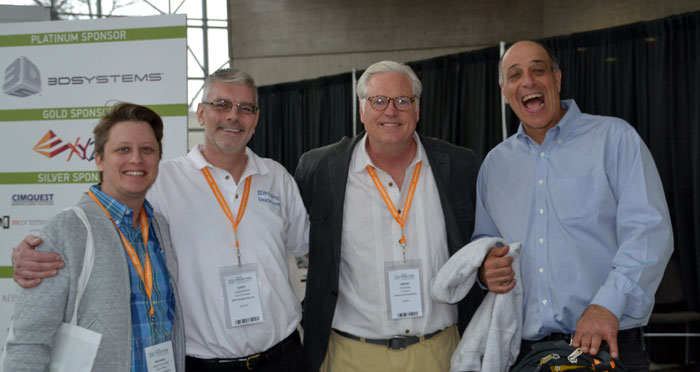I have long followed Autodesk’s CEO, Carl Bass, on twitter (he’s not exactly prolific, rather, insightful), I’ve seen and read most interviews he has given, and, over the years, I have heard from various sources in my contact network about what an amazing/great/awesome guy he is. Today, I got to see a flash of that awesomeness for myself!
Hod Lipson, the conference chair introduced Carl as the morning keynote speaker on Day 2 of Inside 3D Printing, the second NYC edition, with a general observation, saying, “Content generation is PARAMOUNT to the entire 3D printing industry. Many think the software is not keeping up and there is a big gap to fill.”1
Hod rounded up by saying: “No company is doing more to fill these gaps than Autodesk – rapidly.” At which Carl strode on to the stage to address the full room.
He cut straight to the chase and opened by shooting down Hod’s claim of software lagging behind 3D printing: “I’m here to argue the other – 3D Printers are not keeping up with software.” Well, he would say that, he’s CEO of a large, multi-million dollar software company. I did wonder at this point if it would turn into a bit of a sales pitch — it did no such thing, and by the end it was established as one of my favourite presentations of all time.
His delivery was casual, but left you in no doubt that he was well informed and passionate; he was forceful, but not aggressive; and, most important of all, the content was just downright sensible AND entertaining.
He was always going to talk about the software for 3D printing at some level, which he did later on, as he said he would, but first we got a glimpse of his history with 3D printing, which, he told us he first saw 25 years ago, so either an SLA or FDM or DTM SLS. He has personally been 3D printing for the last 15 years, which still puts him ahead of the curve.
Carl then addressed what’s been happening in the last couple of years: “Lots of excitement,” he said, mastering understatement beautifully. “Some of it is deserved, some of it is not.”
He went on to qualify this with his opinion on the oft-stated prediction that there would be a 3D printer in every house — “truly false” he told us. Certainly, I agree with this, as did many around me, it seemed — one hissed “YES!”, while another nodded furiously and yet another tried to master a discreet fist pump! Carl had many from within the industry well and truly on side by this point and we weren’t 5 minutes in. That said, even industry insiders still disagree. Andy Jeffrey, founder of the ceramics 3D printing company that was acquired by 3D Systems, tweeted during the presentation: “I think Carl Bass has it wrong, there will be 3D printers in the home.” There is an obvious disconnect here though. Some people will look to bring it into their homes, of course, however the word that enables both Carl and Andy to both be right in how they frame their views is SOME.
On the other commonly quoted prediction of 3D printing bringing the ‘Next Industrial Revolution’, Carl believes that it “remains to be seen.”
With these realisms firmly rooting his presentation, he went more upbeat saying, “Some things are undeniably awesome.” Using a major benefit of 3D printing technology, namely that shape complexity is free. He showed us some images of a bowl he had designed and after considering how to actually make it there was no other way except with 3D printing
With increasing computing power, design tools, simulation tools and 3D printing he also posited that less skill is required to make things, these days, even complex things.
Going forward, Carl emphasized how developments in material science to expand the variety of what was currently available was one of the most exciting areas, envisaging printing more easily and reliably with the plastics and metals we have today, as well as glass, ceramics, bio materials and so on. This is phenomenal, he imparted, considering its all with the same technique [of adding layers].
Then he crossed back to reality check mode with a single slide presenting issues we still face, which he reeled off very fast indeed, namely:
- strength
- cost
- reliability
- scalability
- size
- speed
- quality
- toxicity.
The take away being that we need to address these issues for 3D printing tech to get even more awesome.
Then he got down to some real nitty-gritty about the state of the industry, basing it on his own experience: “I print a lot” he said, “but my utilization rate is slightly higher than my toaster!”
Laughs aplenty at that one.
And at his peak demand what he really wants is for it to go faster. I know he’s not the only one that wants more speed. And this was not all Carl wants though, saying: “when I want it I want more of it.” The point being that what desktop 3D printers offer, right now, is not enough.
This lead to a general trend he has noticed with 3D printing, specifically that “businesses are developing around the idea of giving us access and experience [to 3D printing] but not ownership.” Thus backing up his belief that a 3D printer in every home is a false notion. “What I think will happen [is that] we all will have access to 3D printers,” likely via a 3D printing service model, either online or locally.
Thus, Carl’s conclusion on this issue — and most important takeaway, IMO — is that “we have way overvalued consumer 3D printing and underestimated industrial 3D printing.”
We need to look at, and focus on, the big picture, namely digital fabrication, of which 3D printing is a part of a much bigger set of technologies. And, according to Carl, that’s where the real industrial revolution is.
And not just digital fabrication in isolation — combine it with traditional, exisiting technologies, examples given were metrology and subtractive manufacturing methods, which, incidentally, are also improving year on year, and then he gets really excited. So much so, his children refer to it as “CNC porn.”
And then he turned his attention to software, 3D printing is impossible without it, after all, and this is Carl’s professional area of expertise. At the basic level, you need a 3D model to 3D print that’s “an absolute.”
With (give or take) 150 different software products, Carl imparted that “almost every customer I know, has an interest in 3D printing, BUT, this is not sufficient for a decent workflow.”
To this end, Carl believes that “voxel modelling and mesh modelling hold great promise,” although as with pretty much every niche within the Digital Fabrication sphere, “we are not there yet!”
In terms of software for improving digital fabrication workflows Carl highlighted Project Miller, a collaborative, free to participate project from Autodesk.
Moving beyond traditional 3D CAD workflows (ie designing from scratch) with the common issues of stl files and fixing issues, Carl touched on the download options. But he is particularly interested in the opportunities presented by 3D scanning, citing the work being done by the Smithsonian (X3D). Michael Raphael, who was sat next to me, did the scans on this. He was as pleased as punch with this recognition.
There was also recognition for “Paranthropus Boisei” a family run archaeological project looking for fossils in Africa, whereby 3D scanning was allowing for the non-destructive cataloguing of fossils and the production of an online museum.
We were also informed about the capabilities of Fusion 360, which permits cloud modelling.
With time passing, which I personally had barely noticed, Carl started rounding up with some of the latest developments across the 3D landscape that he believes will be impactful in the future. He cited the Mark Forged 3D printer that processes single strand carbon fibre; work at the University of Stuttgart working with architectural size structures; the integration of analysis software; a fascinating project coming from Cambrian Genomics, in San Francisco, woking on laser printing DNA, really, 3D printing DNA is underway; and a self-assembling nano scale robot being developed at MIT!
Thus, Carl said, in closing, while he may have thrown “some darts … in general Additive Manufacturing will be incredibly important.”
I managed to nab a couple of minutes with him at the end before the queues formed. I might have moved a bit too quick as he looked a little taken aback and skeptical as I introduced myself. My accent prompted him to ask me if I knew the wonderful Alice Taylor of Makielab, who he had spent some time with recently at SXSW. He visibly relaxed when I said I did, and the lovely Jo Roach. So we did a quick 3D printing round up and I scooted to make way for the scores of people behind me.
But he has certainly made an impression — and I am not the only one. Tweets throughout his talk inferred there were many others in the room who he was impressing too. Not least Arthur Young-Spivey, who tweeted: Carl Bass just became my new 3D Printing Hero …”
I saw him at various times across the rest of the day as he was walking around the exhibition and constantly engaged with exhibitors and visitors alike.
A true gent, with a lot of common sense and even more experience, not to mention quite a bit of power to move things forward in line with his vision.
1. On the ‘content is paramout’ issue — this was a common theme throughout presentations and conversations during the whole event, actually. And that issue brings a whole host of other issues with it — DIY design or scan, if not, where and how to source quality content; and closed or open source?





